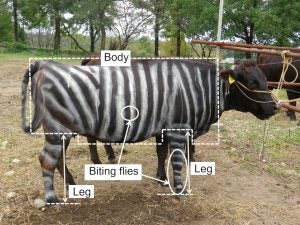The first thing that any of us notice about zebras is the bold black-and-white pattern on their bodies. Many functional hypotheses on the striped pattern of zebras were generated in scientific researches, such as camouflage, confusion of predators, signaling to conspecifics, thermoregulation, and, increasingly popular, the avoidance of biting flies. So a hypothesis was formed that if stripes can help zebras ward off biting flies, perhaps that same tactic would work for cattle.
Biting flies are serious pests for livestock, and previous studies have shown that biting flies affect the behavior of cattle and cause economic losses. In fact, biting flies reduce grazing, feeding, and bedding down time of cattle and increase fly-repelling behaviors (e.g. head throwing, foot stamping, skin twitching, and tail flicking) and bunching behaviors of cattle. Bunching increases heat stress and risk of injury as animals jostle for a better position to avoid biting flies, and this can reduce weight gains in feedlot beef cattle and milk yield in dairy cows.
So a team of researchers looked into how painting stripes on cows would impact the presence of biting flies — their research was published this month in the open-access PLOS One.
While admittedly a time-consuming process, especially for larger farms, the hope was that this would be an environmentally friendly way to control biting flies.

“We show that the numbers of biting flies on Japanese Black cows painted with black-and-white stripes were significantly lower than those on non-painted cows and cows painted only with black stripes,” the authors wrote. “The frequencies of fly-repelling behaviors in cows painted with black-and-white stripes were also lower than those in the non-painted and black-striped cows. These results thus suggest that painting black-and-white stripes on livestock such as cattle can prevent biting fly attacks and provide an alternative method of defending livestock against biting flies without using pesticides in animal production, thereby proposing a solution for the problem of pesticide resistance in the environment.”
Past research has shown that biting flies eschew landing on white, striped, and spotted surfaces. Stripes narrower than a critical width (approximately 5 cm) and spots smaller than a threshold size (diameter approximately 10 cm) effectively prevent biting flies from landing and these surfaces attract fewer biting flies than white surfaces.
Cows were tested by being painted either with black-and-white stripes, painted all in black, or not being painted at all. Commercial waterborne white lacquers were used to create the B&W treatment and commercial waterborne black lacquers to create the black treatment. All procedures were approved by the Animal Use and Care Committee of the Aichi Agricultural Research Center.
Overall, the results showed that the total numbers of biting flies on legs, body, and the sum of legs and body for black-and-white-painted cows were almost half those on the unpainted and the all-black cows.
While the amount of labor involved to apply and reapply the coloring means it’s unlikely we’ll see masses of zebra-striped cattle running around any time soon, it’s certainly interesting to see the alternatives that are being explored to improve animal health.


